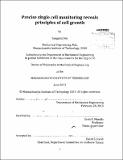| dc.contributor.advisor | Scott R. Manalis. | en_US |
| dc.contributor.author | Son, Sungmin | en_US |
| dc.contributor.other | Massachusetts Institute of Technology. Department of Mechanical Engineering. | en_US |
| dc.date.accessioned | 2013-10-24T17:46:42Z | |
| dc.date.available | 2013-10-24T17:46:42Z | |
| dc.date.copyright | 2013 | en_US |
| dc.date.issued | 2013 | en_US |
| dc.identifier.uri | http://hdl.handle.net/1721.1/81707 | |
| dc.description | Thesis (Ph. D.)--Massachusetts Institute of Technology, Dept. of Mechanical Engineering, 2013. | en_US |
| dc.description | Cataloged from PDF version of thesis. | en_US |
| dc.description | Includes bibliographical references (p. 104-107). | en_US |
| dc.description.abstract | Accumulation of mass is a fundamental cellular process that is associated with metabolism, signaling and regulation. Despite the wealth of knowledge in molecular processes the principles of growth in mammalian cells are poorly understood since growth has never been monitored with high precision. Development of the Suspended Microchannel Resonator (SMR), a microfluidic mass measurement system, enables femtogram cell mass resolution. With this, we developed a method to simultaneously measure molecular signals and single cell mass with high precision over multiple generations. First we investigated how cells control their size. It is known that proliferating cells govern the rate at which they build their biomass and divide, but the mechanism that is used to maintain size homeostasis remains unclear. We obtained over 1,000 hours of growth data from mouse lymphoblast and pro-B-cell lymphoid cell lines. Cell lineage analysis revealed a decrease in the growth rate variability at the G1/S phase transition, which suggests the presence of a growth rate threshold for maintaining size homeostasis. We could also identify unexpected aspects of the growth trajectory such as continuation of growth during M phase, large and switch-like drop in growth rate upon cytokinesis. We next studied the metabolic and energetic requirements necessary for cell growth by monitoring immediate single cell growth response to nutrient depletion. To this end, we developed a method to gently exchange the fluid surrounding a cell while constantly monitoring cell growth. We observed that cells immediately change the growth rate upon depletion of key nutrients such as glucose or glutamine. The growth rate change was surprisingly large but restored upon repletion of nutrients. This implies that immediate growth response integrates both loss of nutrient uptake and signaling associated with metabolism of the particular nutrient. We developed two platforms to measure single cell growth in high throughput. These advancements will broaden the application of the SMR to the study of primary cells or cancer cells. | en_US |
| dc.description.statementofresponsibility | by Sungmin Son. | en_US |
| dc.format.extent | 107 p. | en_US |
| dc.language.iso | eng | en_US |
| dc.publisher | Massachusetts Institute of Technology | en_US |
| dc.rights | M.I.T. theses are protected by
copyright. They may be viewed from this source for any purpose, but
reproduction or distribution in any format is prohibited without written
permission. See provided URL for inquiries about permission. | en_US |
| dc.rights.uri | http://dspace.mit.edu/handle/1721.1/7582 | en_US |
| dc.subject | Mechanical Engineering. | en_US |
| dc.title | Precise single cell monitoring reveals principles of cell growth | en_US |
| dc.type | Thesis | en_US |
| dc.description.degree | Ph.D. | en_US |
| dc.contributor.department | Massachusetts Institute of Technology. Department of Mechanical Engineering | |
| dc.identifier.oclc | 860982906 | en_US |
